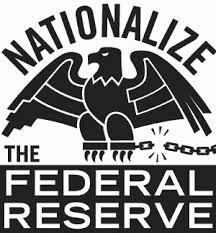The president has criticized Federal Reserve policy for undermining his attempts to build the economy. The best way to make the central bank serve the needs of the economy is to make it a public utility.
For nearly half a century, presidents have refrained from criticizing the "independent" Federal Reserve; but that was before Donald Trump. In response to a question about Fed interest rate policy in a CNBC interview on July 19, 2018, he shocked commentators by stating, "I'm not thrilled. Because we go up and every time you go up they want to raise rates again. . . . I am not happy about it. . . . I don't like all of this work that we're putting into the economy and then I see rates going up." He acknowledged the central bank's independence, but the point was made: the Fed was hurting the economy with its "Quantitative Tightening" policies and needed to watch its step.
In commentary on CNBC.com, Richard Bove contended that the president was positioning himself to take control of the Federal Reserve. Bove said Trump will do it "both because he can and because his broader policies argue that he should do so. . . . By raising interest rates and stopping the growth in the money supply [the Fed] stands in the way of further growth in the American economy."
Bove noted that in the second quarter of 2018, the growth in the money supply (M2) was zero. Why? He blamed "the tightest monetary policy since Paul Volcker, whose policies in the mid-1980s led to back-to-back recessions." The Fed has raised interest rates seven times, with five more scheduled, while it is shrinking its balance sheet by $40 billion per month, soon to be $50 billion per month.
How could the president take control? Bove explained:
The Board of Governors of the Federal Reserve is required to have seven members. It has three. Two of the current governors were put into their position by President Trump. Two more have been nominated by the president and are awaiting confirmation by the Senate. After these two are put on the Fed's board, the president will then nominate two more to follow them. In essence, it is possible that six of the seven Board members will be put in place by Trump.
Those seven, along with five federal district bank presidents, compose the Federal Open Market Committee, which sets monetary policy; and one of those district bank presidents, Minnesota Fed head Neel Kashkari, is already arguing against further rate increases. Bove concluded:
The president can and will take control of the Fed. It may be recalled when the law was written creating the Federal Reserve the secretary of the Treasury was designated as the head of the Federal Reserve. We are going to return to that era.
Returning the Fed to Treasury control, however, means more than appointing new Board members. It means "nationalizing" the central bank, making it a public utility responsive to the needs of the public and the economy. And that means modifying the Federal Reserve Act to change the Fed's mandate and tools.
The Controversial History of Central Bank Independence
Ever since the 1970s, the Fed and other central banks have insisted on their independence from political control. But according to Timothy Canova, Professor of Law and Public Finance at Nova Southeastern University, independence has really come to mean a central bank that has been captured by very large banking interests. It might be independent of oversight by politicians, but it is not a neutral arbiter. This has not always been the case. During the period coming out of the Great Depression, says Canova, the Fed as a practical matter was not independent but took its marching orders from the White House and the Treasury; and that period was the most successful in American economic history.
According to Bernard Lietaer, a former Belgian central banker who has written extensively on monetary innovation, the real job of central bankers today is to serve the banking system by keeping the debt machine going. He writes:
[W]e can produce more than enough food to feed everybody, and there is definitely enough work for everybody in the world, but there is clearly not enough money to pay for it all. The scarcity is in our national currencies. In fact, the job of central banks is to create and maintain that currency scarcity. The direct consequence is that we have to fight with each other in order to survive.
The rationale for central bank independence dates back to a bout in the 1970s of "stagflation" -- rapidly rising prices along with stagnant productivity. The inflation surges were blamed on political pressure put on Fed Chairman Arthur Burns by the Nixon administration to follow easy-money policies. But the link between easy-money policies and inflation is not at all clear. The Japanese have had near-zero interest rates for two decades and cannot generate price inflation although they are trying to. An alternative explanation for the rising prices of the 1970s is that producers' costs had gone up, largely from increased labor costs due to the strong bargaining power of unions and the skyrocketing cost of oil from an engineered 1973-74 oil crisis.
(Note: You can view every article as one long page if you sign up as an Advocate Member, or higher).






